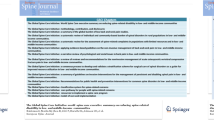Abstract
The main goal of improving pain and neurological deficit in the practice of spine surgery is changing for a more ambitious goal, namely to improve the overall quality of life and the future of patients through three major actions (1) preserving the vertebral anatomical structures; (2) preserving the paravertebral anatomical structures; and (3) preserving the functionality of the segment. Thus, three new concepts have emerged (a) minimal surgery; (b) minimal access surgery; and (c) motion preservation surgery. These concepts are covered in a new term, minimally invasive spine surgery (MISS) The term “MISS” is not about one or several particular surgical techniques, but a new way of thinking, a new philosophy. Although the development of minimally invasive spine surgery is recent, its application includes all spine segments and almost all the existing conditions, including deformities.
Evidence-based medicine (EBM), a term coined by Alvan Feinstein in the 1960s (Feinstein A (1964) Annals of Internal Medicine 61: 564–579; Feinstein A (1964) Annals of Internal Medicine 61: 757–781; Feinstein A (1964) Annals of Internal Medicine 61: 944–965; Feinstein A (1964) Annals of Internal Medicine 61: 1162–1193.), emphasizes the possibility of combining art and science following the strict application of scientific methods in the treatment of patients (Feinstein A (1964) Annals of Internal Medicine 61: 944–965; Feinstein A (1964) Annals of Internal Medicine 61: 1162–1193.), which may represent the advantages of objectivity and rationality in the use of different treatments (Fig. 11). However, EBM has many obvious defects, especially in spine surgery it is almost impossible to develop double-blind protocols (Andersson G, Bridwell K, Danielsson A, et al (2007) Spine 32: S64–S65.). In most cases, the only evidence one can find in the literature is the lack of evidence (Resnick D (2007) Spine 32:S15–S19.), however, the lack of evidence does not mean its absence. Only then, with a rigorous self-analysis, we may take a clear path towards a new philosophy in spine surgery. Of course, feedback from patients through satisfaction and clinical scales can guide our direction and provide the energy needed to maintain the enthusiasm (Fig. 12).
Access this chapter
Tax calculation will be finalised at checkout
Purchases are for personal use only
Similar content being viewed by others
References
Adams M, Roughley Peter (2006) What is Intervertebral Disc Degeneration, and What Causes it? Spine 31: 2151–2161.
Andersson G, Bridwell K, Danielsson A, et al (2007) Evidence-Based Medicine Summary Statement. Spine 32: S64–S65.
Bailey Ch, Fisher CH, Dvorak M (2004) Type II Error in the Spine Surgical Literature. Spine 29: 1146–1149.
Elizondo A (2002) El Conocimiento. In Elizondo A (Ed) Metodología de la Investigación Contable. México DF: International Thompson Editores, S.A.
Feinstein A (1964) Scientific Methodology in Clinical Medicine. I. Introduction, Principles, and Concepts. Annals of Internal Medicine 61: 564–579.
Feinstein A (1964) Scientific Methodology in Clinical Medicine. II. Classification of Human Disease by Clinical Behavior. Annals of Internal Medicine 61: 757–781.
Feinstein A (1964) Scientific Methodology in Clinical Medicine. III. The Evaluation of Therapeutic Response. Annals of Internal Medicine 61: 944–965.
Feinstein A (1964) Scientific Methodology in Clinical Medicine. IV. Acquisition of Clinical Data. Annals of Internal Medicine 61: 1162–1193.
Gray G (2002) Evidence-Based Medicine: An Introduction for Psychiatrists. Journal of Psychiatric Practice 8: 5–13.
Hanson B (2007) The Quest for the New. In Szpalski M, Gunzburg R, Le Huec J, Brayda-Bruno M (Eds) Nonfusion Technologies in Spine Surgery. Philadelphia: Lippincott Williams & Wilkins.
Mayer M (2006) Minimally Invasive Spine Surgery. In: Mayer M (Ed) Minimally Invasive Spine Surgery. A Surgical Manual. Germany: Springer.
Resnick D (2007) Evidence-Based Spine Surgery. Spine 32: S15–S19.
Rulffes W (2006) Technological Advances of Surgical Microscopes for Spine Surgery. In: Mayer M (Ed) Minimally Invasive Spine Surgery. A Surgical Manual. Germany: Springer.
Saarni S, Gylling H (2004) Evidence Based Medicine Guidelines: A Solution to Rationing or Politics Disguised as Science? Journal of Medical Ethics 30: 171–175.
Smith D (2008) Viewpoint: Envisioning the Successful Integration of EBM and Humanism in the Clinical Encounter: Fantasy or Fallacy? Academic Medicine 83: 268–273.
Weiner B (2008) Spine Update. The Biopsychosocial Model and Spine Care. Spine 33: 219–223.
Author information
Authors and Affiliations
Corresponding author
Editor information
Editors and Affiliations
Rights and permissions
Copyright information
© 2011 Springer-Verlag/Wien
About this chapter
Cite this chapter
José-Antonio, SS., Baabor-Aqueveque, M., Silva-Morales, F. (2011). Philosophy and Concepts of Modern Spine Surgery. In: Alexandre, A., Masini, M., Menchetti, P. (eds) Advances in Minimally Invasive Surgery and Therapy for Spine and Nerves. Acta Neurochirurgica Supplementum, vol 108. Springer, Vienna. https://doi.org/10.1007/978-3-211-99370-5_5
Download citation
DOI: https://doi.org/10.1007/978-3-211-99370-5_5
Published:
Publisher Name: Springer, Vienna
Print ISBN: 978-3-211-99369-9
Online ISBN: 978-3-211-99370-5
eBook Packages: MedicineMedicine (R0)




